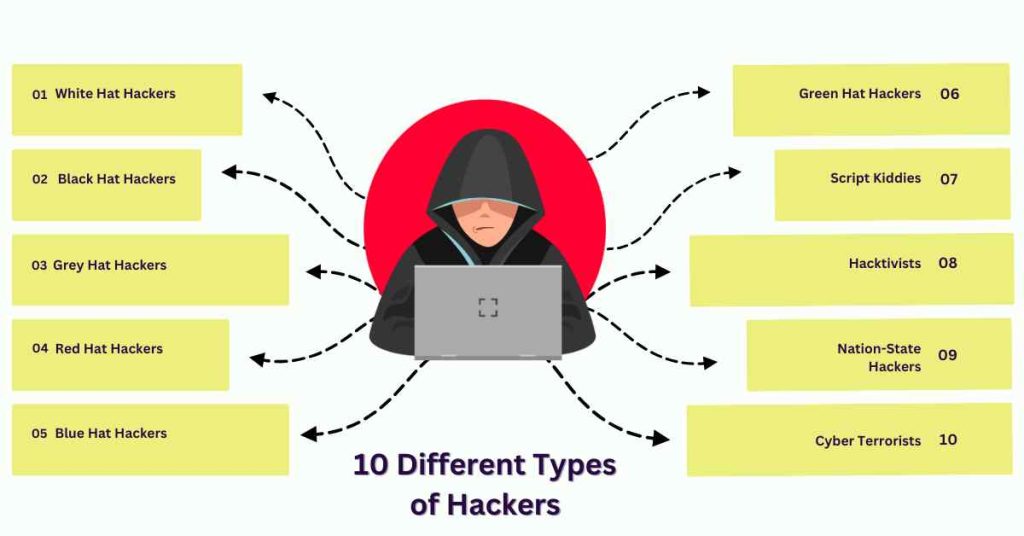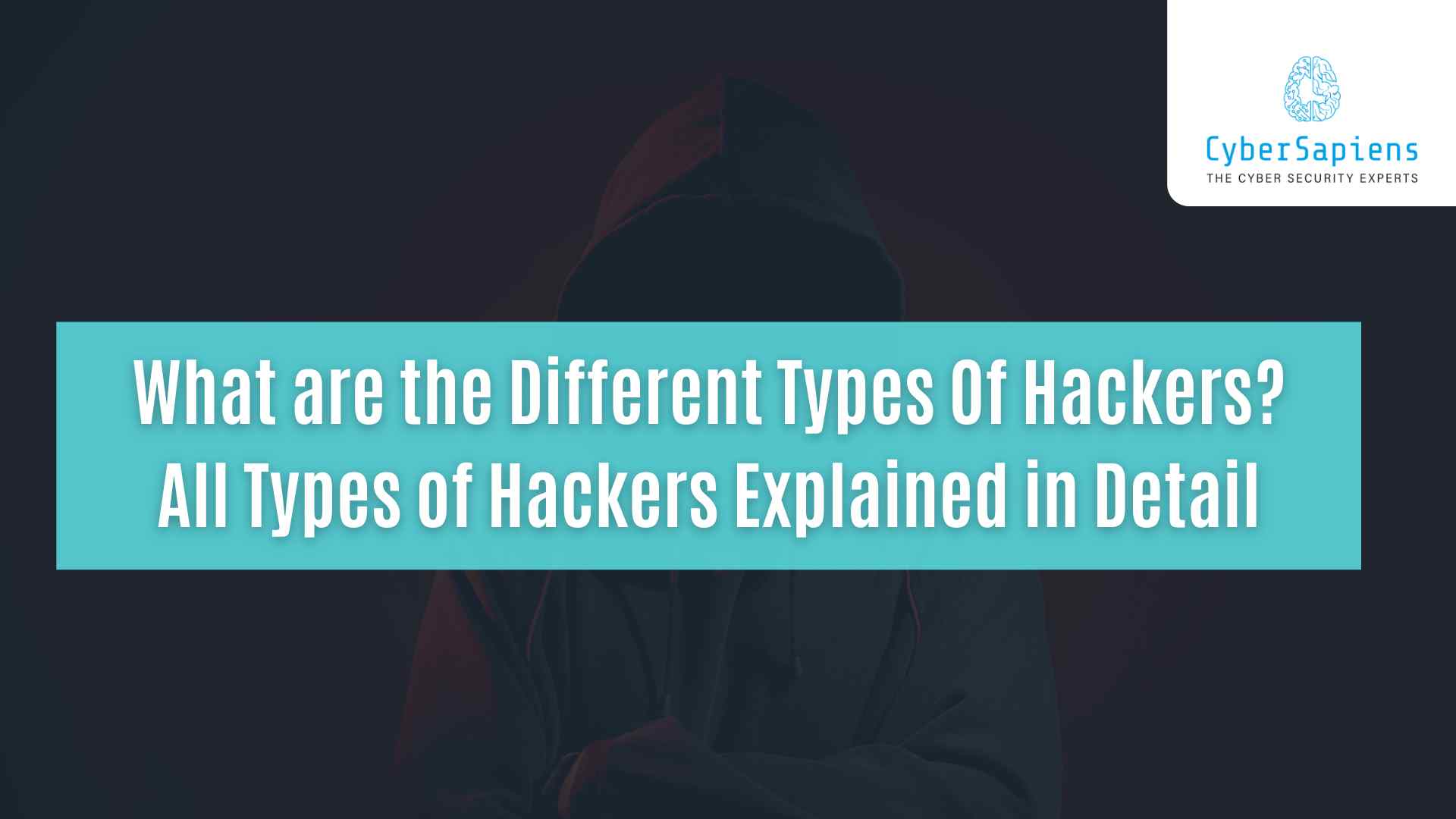When the word hacker comes up, what comes to mind? -that shadowy figure in a hoody, drowned by the ghostly glow emitting from the machine? Many do. Yet, not all hackers are sinister figures in dark rooms.
The hacker universe is filled with varied roles, motives, and ethical codes. Some aim to protect, others to exploit, and some simply revel in the challenge. Understanding these “digital personas” can arm us with insight and awareness, so we can move a bit more safely through the online maze.
Let’s begin with understanding What are the Different Types Of Hackers?
What is Hacking?
Think of hacking as a digital locksmith at work—finding, testing, and sometimes exploiting vulnerabilities. While sometimes it’s to test security, other times, it’s for less noble reasons.
Hacking in itself is neither good nor evil, but depends on intentions and techniques. At its heart, hacking is curiosity, skill, and a great love of problem-solving. But whether those talents serve good or evil often boils down to a hacker’s code of ethics.
Why Knowing the Different Types of Hackers Matters?
Understanding hacker types is like knowing the cast of a mystery novel—it helps you differentiate the heroes from the villains. Grasping the motivations, strengths, and styles of each type is key to protecting against them, just as you might lock your doors differently in various neighbourhoods.
List of Major 10 Different Types of Hackers

Meet the many faces of hacking, each with its codes and causes, making up the cyber landscape. Let’s break down the major types, from those with noble motives to those who disrupt and destroy.
1. White Hat Hackers (The Guardians)
If law enforcement is like white hat hackers in the cyber world, they’re always looking for security flaws—not to take advantage of them, but to keep people safe. These are the ethical professionals you want on your side.
Example: Google has bug bounty programs under which white hats are recompensed for exposing flaws. The hackers get their recognition and remuneration while companies build their defences stronger.
Key Traits: Law-abiding, privacy-respecting, often hired for audits and security checks. These are the unsung heroes keeping systems safe.
2. Black Hat Hackers (The Rogues)
On the shady side of the line, black hats operate in hiding and for personal interest. Black hats exploit systems for a range of personal achievement, causing damage, or wilfully profiting at the expense of the owners.
Example: Ransomware groups like REvil that infiltrate systems, encrypt data, and demand a ransom to unlock it. Essentially, these organizations are holding data hostage.
Defining Characteristics: Profit-driven, employing malware, phishing, and data theft. Black hats operate outside the law, causing potentially devastating financial and reputational damage.
3. Grey Hat Hackers (The Rule-Benders)
Here comes the murky stuff. Grey hat hackers don’t do things to harm, though they never wait for permission. Some consider it an innocent-thinking curiosity that straddles the border of the moral line walking to invade a locked door.
Example: A grey hat might test a site’s security, later informing the company—and possibly expecting a reward or gratitude.
Traits: Operating in the grey area, with no malicious intent but questionable methods. Sometimes, their curiosity edges dangerously close to illegal.
4. Red Hat Hackers (The Vigilantes)
Red hat hackers are cyber vigilantes, counter-hacking black hats to protect others. They don’t hesitate to break rules if it means taking down malicious actors.
Example: A red hat might erase stolen data from a black hat’s server or disrupt illegal operations to “balance the scales.”
Key Features: Driven by protection but prone to extreme methods. Red hats are the “take-no-prisoners” type, blurring lines between hero and outlaw.
5. Blue Hat Hackers (The Specialists)
Called in from outside, blue hat hackers are typically consultants or freelancers brought in to test security before a new release. They’re the inspectors, ensuring everything’s up to code.
Example: Companies hire blue hats to stress-test a new product, identifying vulnerabilities before a public launch.
Characteristics: Project-based, providing fresh perspectives. Blue hats spot issues that in-house teams may miss.
6. Green Hat Hackers (The Newcomers)
Green hat hackers are the eager trainee in hacking. They’re still learning, absorbing all they can from experienced hackers. Sometimes, though, their inexperience can lead to accidental trouble.
Traits: Beginners without formal training, learn through online communities. Though mostly harmless, their lack of experience can occasionally cause unintended harm.
7. Script Kiddies (The Dabblers)
Script kiddies are hobbyists more than hackers, using pre-made scripts to meddle without fully understanding how they work. Think of them as teens setting off firecrackers just because they can.
Traits: Relying on borrowed tools, they hack “for fun,” not purpose. Script kiddies might not be dangerous individually, but they can still cause disruptions.
8. Hacktivists (The Cyber Activists)
Hacktivists have a cause. They are the digital protesters using hacking to make a point, typically directed against the government agencies or corporations.
Example: The well-known hacktivist group Anonymous has directed attacks against censorship, corruption, and various other issues.
Characteristics: Usually ideological or politically conscientious, usually doing website defacements and DoS attacks with blurred boundaries between them.
9. Nation-State Hackers (The Cyber Spies)
Work as agents of their respective governments, often indulging in cyber spying, surveillance, or at times even sabotage. This is a highly skilled and funded variety, and such can have a far-reaching impact.
Example: Some forms of cyberattacks, attributed to state-sponsored groups from Russia or China, intend to steal sensitive documents and hack into systems in rival nations.
Traits: Government-backed with access to extensive resources, focused on espionage, data theft, and, sometimes, destabilization.
10. Cyber Terrorists (The Disruptors)
On the other end of the spectrum, cyber terrorists want to spread havoc; they often set their sights on critical infrastructure, their goal to incite fear or create irrevocable harm.
Characteristics: Many of these terrorists are motivated ideologically and target critical services such as energy or transportation networks. Cyber terrorists entail severe threats to national security.
Types of Hackers-Revelation and Their Tactics
The identification of these types of hackers resembles the process of picking up characters in a novel. Each has a “tell,” revealing their motives and methods. Here are the key differences:
| Hacker Type | Motivation | Typical Actions |
| White Hat | Ethical hacking | Security audits, penetration testing |
| Black Hat | Profit, personal gain | Malware, phishing, data theft |
| Grey Hat | Ethical/Unethical mix | Unauthorised vulnerability checks |
| Red Hat | Vigilante motives | Counter-hacking black hats |
| Blue Hat | Outsourced for security | Freelance vulnerability testing |
| Hacktivist | Social/political causes | Website defacement, DoS attacks |
| Nation-State | National interests | Espionage, infrastructure sabotage |
| Cyber Terrorist | Ideological | Targeting critical infrastructure |
Summary
Here is a quick summary of different types of hackers.
- White Hat Hackers (The Guardians)
- Black Hat Hackers (The Rogues)
- Grey Hat Hackers (The Rule-Benders)
- Red Hat Hackers (The Vigilantes)
- Blue Hat Hackers (The Specialists)
- Green Hat Hackers (The Newcomers)
- Script Kiddies (The Dabblers)
- Hacktivists (The Cyber Activists)
- Nation-State Hackers (The Cyber Spies)
- Cyber Terrorists (The Disruptors)
Conclusion
Today the knowledge of different types of hackers is of utmost importance. From the white hats, protecting our systems, to those nasty black hats sending malware prowling for vulnerabilities, there is a distinct role for every hacker type in the cyber realm.
By understanding hacker intentions and methods, organizations and individuals better defend themselves against threats while appreciating the intricacy of this ever-evolving field. Ultimately, knowledge is power, and being aware of the hacker ecosystem can help bring about a safer online environment for all.
FAQs: What are the Different Types Of Hackers?
1. Which type of hackers are bad?
Ans: Black Hat hackers: The obvious “bad guys”, Black hat hackers are dangerous, highly skilled, and motivated by personal and financial gain. They hack with malicious intent, and they leverage their knowledge of programming languages, network architecture, and networking protocols.
2. Who is a blue hat hacker?
Ans: Blue hat hackers aren’t amateurs or script kiddies like the green hat hackers. They are experts who focus on penetration tests, malware analysis and vulnerability assessment. They are hired by organizations or security firms to identify and assess security weaknesses, usually before a product release.
3. What do hackers love most?
Ans: Hackers Love Phishing. Phishing remains one of the most effective methods hackers use to attack.
4. What do hackers wear?
Ans: One of the main reasons hackers opt for hoodies is the desire for anonymity. In the online world, where identities can easily be concealed, a hoodie can further obscure one’s face and make it harder for authorities to identify them. It’s like wearing a digital mask, allowing hackers to operate in the shadows.
5. What is the salary of a white hacker?
Ans: Average Salary of an Ethical Hacker in India 2024, The average salary for an Ethical Hacker in India is ₹4,20,000 per annum. The average additional cash compensation in terms of perks and benefits is ₹2,70,000 per annum. The range of cash compensation is between ₹1,68,000 and ₹6,00,000 per annum.
6. Who was the first hacker?
Ans: John Draper is considered by many to be one of the first major hackers of the modern era. He gained notoriety for hacking into the phone system in the 1970s, and once claimed he was able to get a call through a secure line to then-President Richard Nixon.












